

How To Write a Scholarship Application Letter (With Template)
Scholarships provide crucial financial support for students pursuing higher education. A thoughtful, well-written application letter can help you make a compelling case to win a scholarship.
Key Takeaways:
- Tailor your letter to the sponsor’s requirements and highlight your relevant qualifications.
- Share details on your background, academic achievements, skills, goals and need for the scholarship.
- Use a professional format with clear organization and follow scholarship guidelines.
- Proofread carefully and have others review before submitting your letter.
Got No Time? A Quick Answer for You:
When writing a scholarship application letter, first review the requirements to understand what the sponsor is looking for. Introduce yourself and explain why you are applying in the opening. Discuss your relevant accomplishments, skills, goals and need for funding in the body. Conclude by thanking the committee and confirming your contact information. Use a professional format, proofread carefully and get feedback from others before submitting.
Let’s get started on crafting a scholarship application letter that showcases your unique strengths and passion. With a focused, engaging letter, you can increase your chances of securing funding for your academic journey.
What is a Scholarship Application Letter?
A scholarship application letter is a formal document where candidates can make a case for why they should receive academic funding from an institution, organization or individual.
The letter allows you to introduce yourself, share your background and interests, and highlight achievements and skills that make you deserving of the scholarship.
While specific requirements vary, application letters generally include:
- An introduction explaining who you are and why you want the scholarship
- Body paragraphs detailing relevant experiences, accomplishments, activities, and skills
- A closing inviting further discussion and providing contact information
The letter provides the opportunity to showcase your qualifications beyond what’s in your transcript and resume. A well-crafted letter can help you make a memorable impression and stand out from other applicants.
How to Write an Impressive Scholarship Application Letter
Follow these key steps when drafting your scholarship application letter:
1. Review the Scholarship Requirements
The first step is to closely review the scholarship requirements and organization’s website to understand what they are looking for in strong candidates.
Pay attention to:
- Eligibility criteria like GPA, field of study, etc.
- Mission and values of the organization
- Key attributes and qualifications they want applicants to highlight
This information will help guide what details you emphasize in your letter. You want to tailor the content to align with their priorities.
2. Craft an Engaging Introduction
The introduction paragraph is your chance to make a strong first impression. Include key details like:
- Your full name, field of study/major, and year in school (high school senior, college junior, etc.)
- Why you are excited to apply for this scholarship
- How the funding will support your academic and eventual career goals
This gives helpful context about who you are and why the scholarship is important to you.
Here is a sample introduction:
My name is Jennifer Smith, and I am currently a high school senior at Jefferson High School planning to attend Washington State University next year. I am very excited to apply for the Women in STEM Scholarship, which would enable me to pursue my dream of studying engineering and eventually designing renewable energy solutions.
3. Highlight Relevant Experiences and Achievements
The body paragraphs should focus on your strengths as a student and person. Think about the key attributes, accomplishments and skills you want to highlight that align with the scholarship requirements.
Be sure to provide concrete examples and anecdotes to back up the qualities you present. Don’t just say you’re a hard worker – describe your strong work ethic by listing related achievements.
Here are types of details to include:
- Academic achievements: GPA, honors, advanced courses, involvement in academic clubs related to your major.
- Extracurriculars: Leadership roles, sports teams, community service activities. Discuss skills demonstrated.
- Relevant work experience: Jobs and internships in your field of study. Explain what you accomplished.
- Unique skills and strengths: Language proficiency, communication/teamwork abilities, creativity, initiative, discipline, etc.
- Passion for your major/future career: When did you become interested? Share an experience that sparked your passion. Discuss future goals.
Ideally choose 3-4 focused paragraphs to make your case, rather than covering everything superficially. Quality over quantity.
4. Close With a Summary Statement
Wrap up your scholarship letter with a concluding paragraph that reiterates your enthusiasm and fit for the award. Thank the review committee for considering your application.
Also, include an invitation to contact you directly if they would like to discuss your application or request more information. Provide your:
- Phone number
- Professional email address
- Physical address (optional)
Here’s a sample closing paragraph:
Thank you for your time and consideration of my application. I am incredibly excited by the prospect of receiving the Women in STEM Scholarship and would love to further discuss my qualifications. Please feel free to contact me by email at [email protected] or by cell at 123-456-7890 should you have any questions. I look forward to hearing from you!
5. Proofread and Get Feedback
Before submitting your letter, be sure to carefully proofread for any errors or typos. Read the letter out loud to catch awkward phrasing.
It can also be very helpful to have mentors, teachers, and family members review your letter and provide feedback. A second set of eyes can catch issues you may have missed.
With these steps in mind, let’s look at a template and example scholarship letter to illustrate an engaging structure.
Scholarship Application Letter Template
Review this template when crafting your own scholarship application letter:
[Your Full Name] [Your Phone Number] [Your Email] [City, State]
[Scholarship Organization Name] [Contact Person Name and Title] [Address]
Dear [Contact Name],
Introduction paragraph: State your name, current grade/year in school, intended major, and why you want the scholarship. Share your academic and career goals.
Paragraph 2: Highlight your relevant academic achievements like GPA, honors, awards, and advanced coursework. Mention membership in academic organizations.
Paragraph 3: Discuss extracurricular activities and leadership roles that helped you develop important skills. Share related accomplishments.
Paragraph 4: Mention work experiences and internships in your field of study. Explain skills gained. Share what inspires your passion for your major and future career goals.
Conclusion: Thank the committee for considering your application. Provide your contact information and invite further discussion about your qualifications. Express your enthusiasm for the scholarship opportunity.
[Your Signature] [Your Full Name]
Scholarship Application Letter Example
Read this strong sample scholarship letter for a high school student applying to a local community organization:
Jennifer Smith 123-456-7890 [email protected] Springfield, MO
May 1, 2023
Springfield Women in STEM Scholarship Scholarship Committee 123 Main St. Springfield, MO 65000
Dear Scholarship Committee Members,
My name is Jennifer Smith, and I am currently a senior at Springfield High School who intends to study mechanical engineering at State University next year. I am thrilled to apply for the Springfield Women in STEM Scholarship, which would empower me to pursue my dream of becoming an engineer and innovator.
In high school, I have consistently maintained a 4.0 unweighted GPA while enrolled in multiple honors and AP courses. I am also deeply involved with the Robotics Club, serving as team captain for the past two years. In this leadership role, I have guided our team to win regional robotics competitions and demonstrate key engineering skills.
Beyond classes, I spend time volunteering as a tutor where I have helped dozens of classmates master concepts in math and physics. I also played junior varsity soccer freshman and sophomore year, developing my teamwork, discipline and communication abilities. Through these diverse experiences, I have become a driven, high-achieving student capable of excelling in a STEM degree program and career.
Most of all, I am deeply passionate about science, technology and using my skills to develop solutions to real-world problems. I have known that engineering was my calling since I built my first robot in 7th grade. Coming from a family of engineers, I have long been fascinated by renewable energy and want to help shape future green technologies. Receiving your scholarship would enable me to actively contribute to progress in this field.
Thank you for your consideration of my application. I can be reached any time at 123-456-7890 or [email protected] to further discuss my qualifications. I truly appreciate you taking the time to review my letter, and I hope to join the next class of women in STEM you support.
[Signature] Jennifer Smith
The Key Elements of a Strong Scholarship Letter:
- Customized Content: Tailor your letter to the specific scholarship requirements. Highlight the most relevant parts of your background.
- Well-Organized Structure: Use a professional format with logical flow between paragraphs. Easy to follow.
- Personal Details: Share information beyond just academic stats, like your interests, goals and financial need.
- Polished Writing: Avoid errors. Use clear, concise language that engages the reader.
- Attention to Details: Follow all scholarship guidelines precisely. Confirm eligibility. Submit by deadlines.
Pro Tips for an Exceptional Letter:
- Start early – Give yourself plenty of time to draft and refine your letter. Don’t wait until the last minute.
- Be positive – Avoid sounding desperate. Be gracious and focus on your qualifications rather than just need.
- Express passion – Let your enthusiasm and ambition shine through. Committees want motivated students.
- Proofread meticulously – Carefully check for any spelling, grammar or formatting errors.
- Get feedback – Have teachers, parents and friends review your letter before submitting.
- Send thank you notes – Follow up with thank you notes to show your appreciation.
FAQs About Scholarship Letters:
How long should a scholarship letter be.
There is no standard length – Scholarship letters can range from one to several pages depending on the requirements. Aim for 1-2 pages in most cases. The key is quality over quantity.
Should I send separate letters for each scholarship?
Yes, send customized letters – Avoid submitting the exact same generic letter for different scholarships. Tailor each one.
How do I list community service on a scholarship letter?
Highlight relevant activities – In a paragraph or bullet points, list service projects and how they allowed you to develop useful skills. Quantify hours served when possible.
Can I submit a scholarship letter by email?
Follow the guidelines – Some scholarships want printed letters while others accept email submissions. Carefully check and follow the requested method.
Is a scholarship letter the same as a personal statement?
They are similar but serve different purposes – The personal statement is for college admissions, while the scholarship letter is for financial award consideration.
In Conclusion:
A thoughtful, focused scholarship application letter allows you to introduce yourself beyond transcripts and resumes and make a compelling case for funding. By tailoring your content to the specific organization, highlighting your achievements and skills, and infusing passion throughout, you can craft a memorable letter.
Use the template and tips provided above to get started on your own application letter. Don’t underestimate the power of an engaging, personal letter to help you secure financial support as you pursue your academic and professional aspirations. With focus, planning and polish, your letter can get you one step closer to achieving your dreams!
Editor’s Note: Applying for scholarships can seem daunting, but breaking the process down into manageable steps will set you up for success. Remember to maintain a positive, gracious attitude and express genuine enthusiasm in your letter. Small personal touches and stories make a big impact. You’ve got this! 😊
With over two decades of experience, renowned scholar Dr. John Morris has become the #1 trusted global expert on winning prestigious government scholarships. Having personally received full funding awards from Germany, Brazil, Spain, the UK and Australia during his esteemed educational career, Dr. Morris now dedicates himself to helping disadvantaged students access the same life-changing opportunities through his motivational speeches at universities worldwide and highly popular Scholarships Office blog.
Similar Posts

From Unemployed in Lisbon to a $360K Boston Job in Under 15 Months: Ana’s Incredible Career Transformation
In our fast-changing job landscape, how does one go from being unemployed and seemingly left behind to landing a high paying role in a hot field like data analytics or engineering? That’s the inspiring question answered by Ingrid Norris’ journey from broke in Lisbon to a $360K salary in Boston in an astonishingly short timeframe….

Is Earnest Scholarship Legit? The Truth Behind This Popular Program
Yes, the Earnest Scholarship is a 100% legitimate scholarship program that awards $50,000 annually to students pursuing higher education. The Earnest Scholarship has awarded over $925,000 to 185 college students since its inception in 2019. However, some lingering doubts persist about the scholarship’s legitimacy. Key Takeaways: The Earnest Scholarship is 100% Legit How the Earnest…
![cover letter examples for scholarship Where Does Scholarship Money Go? [Ever Think]](https://scholarshipsoffice.com/wp-content/uploads/2023/09/Where-Does-Scholarship-Money-Go-1-768x448.png)
Where Does Scholarship Money Go? [Ever Think]
When you win a scholarship, the funds are typically sent directly to your college to pay for tuition, fees, and other educational expenses. Any leftover scholarship money after tuition is paid goes directly to you and can be used for additional educational costs like books, a laptop, or housing. Make sure to check with your…
Can You Get a Scholarship for Being Short in 2023?
Key Takeaways: Got No Time? A Quick Answer for you:Yes, there are scholarships available in 2023 specifically for students who are considered short, usually under 5 feet tall. Organizations like Little People of America and the Billy Barty Foundation offer awards to help short students pay for college. Meeting height requirements, demonstrating financial need, and…

How To Write an Erasmus Motivational Letter in 5 Easy Steps
Got No Time? A Quick Answer for you:Writing a compelling Erasmus motivational letter is crucial for getting selected for the program. Follow these key steps – brainstorm your motivations, introduce yourself, explain why you chose the university/city, summarize your goals, and carefully proofread. Highlight your academic achievements, share details on the courses or research you…
Is Scholarship for Moms Legit or a Scam? The Real Truth
Scholarship for Moms is a legitimate scholarship platform that connects moms looking to further their education with potential scholarship opportunities. They do not directly provide scholarships, but partner with organizations that do. While free to use, be cautious about sharing personal information as it could be sold to third parties. Do research on their partners…
Leave a Reply Cancel reply
Your email address will not be published. Required fields are marked *
Save my name, email, and website in this browser for the next time I comment.
- Success Stories
- AI Scholar Program
- Startup Internship Program
- Research Scholar Program
- GOALS Academic Support Program
- Test Prep Program
- Passion Project Program
- For Families
- For Schools
- For Employers
- Partnerships
- Content Guides
- News And Awards
- College Admissions
- Events and Webinars
- Applications
- Pre-Application
How to Create a Student Cover Letter for Scholarships
Julia de Raadt
Head of research and lead admissions expert, table of contents, tips to create cover letter for scholarships, know your strengths with empowerly.
Stay up-to-date on the latest research and college admissions trends with our blog team.

Many students with good grades, high SAT scores, and an extensive list of extracurriculars apply for scholarships every year. However, in order to stand out from the rest of your competition, you need a resume with a strong cover letter for scholarships.
To write a student cover letter, you may need the help of a professor, family, or guidance counselor . This will ensure that your cover letter for a scholarship highlights not only your academic achievements but also your strongest skills and talents. It’s critical that you put your best foot forward.
So, how do you create an impressive cover letter for a scholarship? Well, let us dive right in.
In order for your scholarship application to stand out from the rest, you need to tell a compelling story to the scholarship committee. Therefore, you must use every word carefully when explaining your motivations, accomplishments, and challenges in life.
No matter what type of scholarship you apply for, all cover letter examples for students follow a standard format. So, follow the following steps to write the best cover letter for a scholarship you can.
Tip #1 – Adhere to the Structure
It can be a real challenge to sell yourself to the scholarship committee. Therefore, if you are struggling to start or write a cover letter for a scholarship, knowing the overall outline can help. The structure or format of a student cover letter consists of six main components, which are:
- Personal information – contains your full name, address (if you choose to share), and other contact information, including email address and phone number
- Salutation – always start by addressing “Scholarship Committee” or “Dear Sir/Madam” if you know the name of the specific person responsible for making a decision.
- Opening paragraph – this section must include a summary of your career goals and plans.
- Body – the body must provide details about your educational background, work experience, previous awards and honors, volunteer experience, etc. This section can be two to three paragraphs: one about your academics, and one about your work experience/skills/volunteering experience. The last paragraph must curtail how a scholarship is going to help you achieve your career goals.
- Closing with a call to action – thank the scholarship committee for considering your application, followed by a call to action such as “if you need further information, please feel free to contact me,” etc.
- Sign-off – end the closing letter with “sincerely,” “kind regards,” or “best regards.”
Tip #2 – Be Concise
The idea of a cover letter for scholarships is to give committees an overview of your entire academic journey, motivations, and life from your point of view. However, it does not mean that you have to tell your entire life story—and you’ll definitely want to avoid restating the information that you’ve already written in your resume itself. Keep your cover letter concise by only highlighting a couple of relevant events to your college admission, career goals, and scholarship, and focus on communicating your personal voice.
Therefore, your cover letter for a scholarship must include the following information.
- You must start by giving an overview of your academic self and what your strengths are
- You must demonstrate your academic history and help the scholarship committee see why they should award you the scholarship
- Do not forget to convey your future goals while sounding enthusiastic about the scholarship
- State how you plan to use your scholarship
If you are unsure how to showcase your skills or what your strengths are, take the Empowerly Quiz . This small quiz will evaluate your academic background, work, and volunteer experiences to give you a score. If you sign up to receive your Empowerly Score, your test results will also highlight the strengths that you can use on your resume and cover letter for scholarships.
Tip #3 – Customizing your Cover Letter for Scholarships
As you write a student cover letter, it is the little touch of personalization that will make it unique. Just imagine scholarship committee members coming across a cover letter amongst the pile and finding one that is thoughtful and personalized rather than sounding generic.
The best way to customize your cover letter for a scholarship is to write an introductory paragraph that includes information relevant to that scholarship in particular. Tailoring your cover letter’s body will give your application a better chance of approval as well.
However, the criteria to grant scholarships vary widely. Partnering with Empowerly can help you gain access to guidance, career counseling, and expert advice that will help you make the most of your cover letters and resumes.
Applying for a scholarship is a big challenge. However, having a professional guide or counselor on your side can help you improve your chances of approval. Why not consult with Empowerly ?
Register as an Empowerly student and learn about your best skills and strong suits that you can highlight in your cover letter for scholarships. The Empowerly Score is only available to students in the Empowerly Portal — it’s a separate form and result process that gives you a detailed report. Speak to us to learn more about these resources today!
Share this article:
College apps can be overwhelming, but you don’t have to do it alone. empowerly college counseling is in it with you., related articles.

Student Voice: The Raw, Unfiltered Value of College Counseling
Empowerly Students Receive Early Admissions for University of California Class

Dealing with Application Stress

25,000+ students realised their study abroad dream with us. Take the first step today
Meet top uk universities from the comfort of your home, here’s your new year gift, one app for all your, study abroad needs, start your journey, track your progress, grow with the community and so much more.

Verification Code
An OTP has been sent to your registered mobile no. Please verify

Thanks for your comment !
Our team will review it before it's shown to our readers.

- Interview Preparation /
Scholarship Cover Letter: Samples and Tips
- Updated on
- Dec 7, 2023

Scholarships are a great way to lessen financial stress and support your academic endeavours. Students create a checklist of the papers they will need to apply for scholarships as they get ready for their academic programme. However, the majority of the time, students get overwhelmed and may feel overburdened by the requirement that they have to write a strong cover letter in order to be given consideration for the scholarship. This blog will guide you through the process of writing a scholarship cover letter . Continue reading to know more.
This Blog Includes:
What is a scholarship cover letter, importance of scholarship cover letter, understand the scholarship requirement, incredible introduction, mention your internships and work experience (if any), academic goals, closing paragraph, tips to write a scholarship cover letter , how to structure scholarship cover letter.
Also Read: How to Write an Outstanding Scholarship Application
A cover letter that highlights your interest in a scholarship and explains how it will help you achieve your personal and professional goals is known as a scholarship request letter. It is a letter that a person may use to prove that they are a strong contender for a scholarship. This kind of letter is typically required, along with any other pertinent records, by a university committee. It is a vital resource for seeking financial assistance. Scholarship committees will be impressed and persuaded that you are worthy of their time and money by writing a strong cover letter.
Also Read: How to Write a Cover Letter?
One of the most important papers when applying for a university scholarship is a cover letter. The admissions committee learns about the applicants’ abilities, expertise, experiences, and, most significantly, interests. Additionally, it aids the committee in determining whether or not you are qualified to get a scholarship from the institution. This document not only aids applicants in differentiating their profiles but also aids the scholarship evaluating committee in learning more about the goals and accomplishments of a prospective student.
Also Read: How to Write a Cover Letter for Your First Job?
How to Write a Scholarship Cover Letter?
One of the most challenging tasks for students is writing a cover letter since they have no idea where to begin or what to include. Following the procedures listed below will make creating a cover letter as simple as pie:
You may be able to write your letter more effectively if you have a better knowledge of the scholarship’s criteria. There are many scholarships available for applicants who want to follow the academic programme of their dreams, thus it is crucial for applicants to check the requirements before beginning to write the cover letter. Candidates must be aware that expectations and requirements may vary depending on the university or organisation awarding the scholarship. Understanding the requirements completely can help you customise your scholarship cover letter to fit various needs.
Now, start your cover letter with an introduction paragraph that briefly summarises your background and your motivation for applying for the organization’s scholarship. You might talk about how the organisation links to your academic and professional interests or how getting this award might provide you access to educational possibilities you would not otherwise have.
Furthermore, talk about any internships or professional experience you’ve had, emphasising how it relates to the scholarship or your field of study. The review committee always favours candidates who are dedicated to their professional development and have a passion for learning.
The major purpose of scholarships is to help students with the cost of their education, therefore the examining committee will undoubtedly be curious to learn more about a candidate’s academic goals. Candidates must specify the degree they are interested in, also explain why they are drawn to a specific programme and how it will further their academic and professional goals .
Finally, you may summarise your pursuits and ambitions in the last paragraph after completing the three paragraphs and emphasising your abilities, experience, and interests. You can express your appreciation for getting the chance to apply for the specific scholarship. Lastly, include your contact details.
Also Read: How to Be More Confident
Here are some expert tips to help you craft a compelling cover letter:
- Always utilise measurable achievements.
- Try to remember to add and emphasise any information that hadn’t been in other application documents.
- Tailor your cover letter to the specific scholarship and its requirements.
- Provide a concise but honest explanation of your financial situation and how the scholarship would assist you in fulfilling your dream.
- Remember to follow any specific instructions provided by the scholarship committee or the organisation in particular.
- Maintain a professional demeanour and proofread your final copy before emailing it.
Also Read: Scholarship Application Checklist
Furthermore, here is a structure for a scholarship cover letter and what to include in the document
1. Introduction:
- Clearly state your purpose for writing.
- Mention the specific scholarship you are applying for.
- Briefly introduce yourself and your current academic status.
2. Educational Background:
- Highlight your academic achievements and relevant coursework.
- Emphasize how your current studies align with the scholarship’s focus.
3. Career Goals and Aspirations:
- Discuss your long-term goals and how the scholarship will contribute.
- Showcase your passion and commitment to your chosen field of study.
4. Relevant Experience
- Share any relevant work, research, or volunteer experiences.
- Connect these experiences to the scholarship’s objectives.
5. Why You Deserve the Scholarship:
- Articulate how the scholarship will benefit you and your community.
- Emphasize any unique qualities or experiences that set you apart.
6. Conclusion:
- Summarize key points.
- Express gratitude for the opportunity to apply.
- Include a closing statement and your contact information.
Also Read: Cover Letter for Fresher: Sample, Format, Templates
Samples for Scholarship Cover Letter
Here are the samples for writing a cover letter:
[Your Name]
[Your Address]
[City, State, PIN Code]
[Email Address]
[Phone Number]
[Scholarship Committee’s Name]
[Scholarship Organization’s Name]
Dear [Scholarship Committee’s Name],
I hope this letter finds you in good health and high spirits. I am writing to express my strong interest in applying for the [Name of Scholarship] as an international student pursuing [Your Field of Study] at [University Name]. As a dedicated and motivated student, I am excited about the opportunity to continue my education and contribute to the academic community at [University Name], and I am seeking financial assistance to help me achieve this goal.
Coming from [Your Home Country], I have always had a deep passion for [Your Field of Study] and a strong desire to make a meaningful impact in this field. I chose [University Name] due to its outstanding reputation in [Your Field of Study], and I am confident that the rigorous curriculum and diverse academic environment will provide me with the necessary skills and knowledge to excel in my chosen career path.
I am facing financial challenges that hinder my ability to fully fund my education abroad. My family’s financial situation has been strained due to [Brief Explanation of Circumstances]. Despite these challenges, I remain committed to my education and have maintained a strong academic record throughout my previous studies. I am also actively involved in extracurricular activities, such as [Mention any Relevant Activities], which have helped me develop leadership, teamwork, and time management skills.
Receiving the [Name of Scholarship] would not only alleviate the financial burden on my family but also enable me to concentrate fully on my studies and contribute positively to the university community. I am determined to make the most of this opportunity by excelling academically, participating in research projects, and engaging in community service activities.
Enclosed with this letter, please find my completed scholarship application form, academic transcripts, letters of recommendation, and [Any Other Required Documents]. I am committed to utilizing the scholarship funds responsibly and efficiently, ensuring that they contribute to my academic and personal growth.
I am truly grateful for the consideration of my application and am excited about the possibility of becoming a [University Name] student. Thank you for your time and consideration.
[Your Full Name]
I am writing to express my sincere interest in the [Scholarship Name] as an international student pursuing higher education in [Your Intended Field of Study]. I am excited to present my application for this prestigious scholarship opportunity and demonstrate my commitment to academic excellence, personal growth, and cross-cultural understanding.
Allow me to introduce myself: I am [Your Name], and I hail from [Your Home Country]. I have always been passionate about [Your Field of Interest], and this led me to embark on a journey to explore diverse perspectives and gain a comprehensive education. The opportunity to study abroad and experience new cultures is a dream that I have been working towards, and receiving the [Scholarship Name] would greatly assist me in achieving this goal.
Coming from a background where financial resources are limited, I understand the value of hard work, dedication, and resourcefulness. These values have shaped me into a disciplined and focused individual. Throughout my academic journey, I have maintained a consistently high GPA, showcased leadership skills as [Mention a Leadership Role or Project], and actively participated in [Extracurricular Activities Relevant to Your Field].
One of the main reasons I am drawn to studying in [Your Host Country] is its reputation for academic excellence and innovation in [Your Field of Study]. The research opportunities, advanced curriculum, and collaboration with esteemed professors in this field are unparalleled. By obtaining this scholarship, I would be able to alleviate the financial burden of tuition and living expenses, allowing me to fully immerse myself in my studies and contribute to the academic community.
Furthermore, I believe that being an international student enriches the educational experience for both myself and my peers. Exchanging ideas, sharing perspectives, and building connections with individuals from various cultural backgrounds fosters a more inclusive and open-minded learning environment. I am dedicated to being a cultural ambassador, promoting diversity, and contributing positively to campus life.
In conclusion, I am truly grateful for the opportunity to apply for the [Scholarship Name]. The financial assistance provided by this scholarship would not only support my academic aspirations but also enable me to make a meaningful impact on the global community. I am committed to giving back and utilizing my education to address real-world challenges.
Thank you for considering my application. I am eagerly looking forward to the opportunity to contribute to your institution and fulfil my aspirations. Enclosed are my application materials, including my transcript, letters of recommendation, and other required documents. Please feel free to contact me at [Your Email Address] or [Your Phone Number] if you require any further information.
Enclosures:
Letters of Recommendation
[Other Required Documents]
Hope this article and samples of scholarship cover letters will help you craft your letter in the best possible way.
Also Read: 8 Easy Steps to Write a Cover Letter: Sample Templates
Related Reads:
Yes, scholarship cover letters are also known as letters of motivation that help the reviewing committee to make better decisions.
Yes. Students must prepare an effective cover letter to apply for a scholarship at global universities.
Yes, If you are applying for a scholarship or a research grant, including a cover letter is always the best way to highlight your academic achievements and aspirations.
Follow Leverage Edu for more interesting tips on Interview Preparation.
Nidhi Mishra
Nidhi Mishra is a seasoned senior content writer with more than eight years of diverse experience in the field of education. Her varied career encompasses work in teaching, training, counselling, developing curriculum, and content creation. Nidhi has a solid background in education and has developed her abilities to meet the diverse needs of students, especially students who want to study abroad. Throughout her career, Nidhi has been an invaluable resource to students with their test-taking efforts, offering thorough career assistance and insightful advice on how to navigate the complexity of the system of education. Her speciality is creating interesting and educational content that is specifically designed to fulfil the needs of students who want to pursue higher education abroad. Together with her wonderful writing skills, Nidhi's love of education has allowed her to produce content that has a lasting impression on readers, educators, and students alike. She is committed to providing high-quality, timely, and insightful content because she believes that education can empower people.
Leave a Reply Cancel reply
Save my name, email, and website in this browser for the next time I comment.
Contact no. *

Leaving already?
8 Universities with higher ROI than IITs and IIMs
Grab this one-time opportunity to download this ebook
Connect With Us
25,000+ students realised their study abroad dream with us. take the first step today..

Resend OTP in

Need help with?
Study abroad.
UK, Canada, US & More
IELTS, GRE, GMAT & More
Scholarship, Loans & Forex
Country Preference
New Zealand
Which English test are you planning to take?
Which academic test are you planning to take.
Not Sure yet
When are you planning to take the exam?
Already booked my exam slot
Within 2 Months
Want to learn about the test
Which Degree do you wish to pursue?
When do you want to start studying abroad.
January 2024
September 2024
What is your budget to study abroad?

How would you describe this article ?
Please rate this article
We would like to hear more.
Have something on your mind?

Make your study abroad dream a reality in January 2022 with
India's Biggest Virtual University Fair

Essex Direct Admission Day
Why attend .

Don't Miss Out

How to Write a Good Cover Letter for Scholarship Application (5 Sample Examples PDF)
Scholarship Application 14,204 views 06 April, 2022
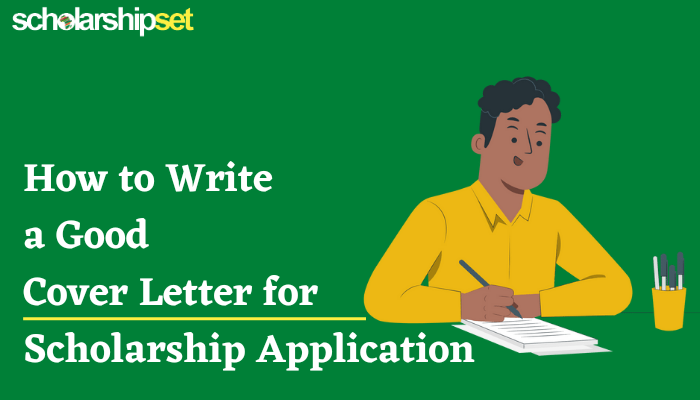
Do you need to write a good cover letter for scholarship, or you are in search of scholarship cover letter samples to guide you with your scholarship request? This article provides cover letter format for scholarship application, as well as cover letter for scholarship application pdf examples as templates for you to start writing your proposal letter for scholarship.
Every scholarship evaluation board or committee have a lot to take into consideration when making the decision on who to award a scholarship to. Decisions can be based on academic excellence and skills, or on economic factors such as low income.
In many cases when applying for a scholarship, the scholarship committee may ask you to attach a scholarship application cover letter. You should also provide details about how the scholarship will help you reach your educational and career goals when writing a cover letter for a scholarship.
Note that your letter of interest for scholarship, is one of your best chances to stand out from other candidates applying for the same scholarship, and you need to take it seriously. Read on to find out some tips on how to write a simple application letter for scholarship, which can also become the best cover letter for scholarship application when compared to cover letters from other candidates.
Related: How To Write A Good Recommendation Letter For Scholarship Application (8 Sample Examples PDF)
Article guide:.
What is a scholarship cover letter?
Parts of a cover letter for scholarship
TIPS: What to do when writing a cover letter for scholarship application
TIPS: What not to do when writing a cover letter for scholarship application
Letter formatting for a scholarship cover letter
Sample cover letter for scholarship application
Other sample examples of cover letter for scholarship application
What is a Scholarship Cover Letter?
A cover letter for scholarship application is an important and useful document that gives applicants for a scholarship the opportunity to express themselves and also provide details about their capabilities and goals.
A scholarship proposal letter which should be written to a scholarship committee, should explain what makes you a great candidate for the award, because the scholarship committee wants to find the most fitting students to invest their money in. Make them see the reasons why they should they choose you.
There are lots of applicants with excellent academic record who fit the bill of a great scholarship candidate. However, many scholarship committees look beyond just grades when choosing their preferred candidate for the award.
They look at students who have overcome struggles, as well as students who are leaders in their community, with unique hobbies. Your cover letter for award application is your best choice at convincing the scholarship committee.
Parts of a Cover Letter for Scholarship
Whether you are writing for an undergraduate scholarship award, or a cover letter for masters’ scholarship, or a cover letter for PhD scholarship, you need to ensure that your cover sheet for scholarship application meets the application standards.
Specifically, there are five parts of a cover letter for applying scholarship.
Personal information
Just like every other ordinary letter, there must be a head section that shows your full name, department, University name, and address, on your cover page for scholarship application.
Salutation and opening paragraph
Start with an opening paragraph that briefly introduces who you are, and your relevant experience, how you learned about the scholarship, and why you are interested in applying.
Body paragraph(s)
What you are really addressing in this section is what makes you deserving of this particular scholarship, so make sure that everything you include in your cover letter for scholarship essay, bolsters your case. You may need just one body paragraph or several (always check the length requirement first).
Closing paragraph
End your application cover letter for scholarship with a closing paragraph that restates your interest in the scholarship and why you should be considered. Include a call to action to inspire the committee to reach out to you.
You can do this with a simple "sincerely / best regards", your full name and signature.
TIPS: What to do When Writing a Cover Letter for Scholarship Application
When writing a cover letter applying for scholarship, here are some tips on what you should do:
Be polite and honest
You don't need to write your family problems all at once in your scholarship cover letter. Simply explain your reason for needing financial aid in a polite and clear manner.
Keep your letter concise
When writing a cover letter for scholarship, you should try to make it short and direct as possible.
Attach necessary documents
On submitting your scholarship cover letter, ensure that you attach necessary documents that prove the validity of your challenges to make your story convincing.
Submit your request on time
Submit your cover letter as soon as possible to give your college ample time to review your request.
Go by the book
Stick to the college's procedure on how to appeal the initial scholarship package.
TIPS: What Not to Do When Writing a Cover Letter for Scholarship Application
Here are some tips on what you should avoid when writing a cover letter for scholarship:
Do not neglect your achievements
When writing a cover letter for scholarship application, don't feel timid to include details about your hard work and success record.

Do not show arrogance
You didn't save money with a scholarship committee for your education. Therefore, you shouldn't sound rude or too demanding when writing your cover letter.
Do not generalize your address
Don't just address your cover letter directly to the scholarship committee office, if possible, address your cover letter directly to the designated person at the committee office.
Don't be in a haste to submit your letter
Do not send your scholarship cover letter without proofreading for possible grammatical errors.
Avoid unnecessary complaints
Remember your cover letter is not for you to write about historical problems in your family, so avoid complaining too much or demanding too much sympathy.
Letter Formatting for a Scholarship Cover Letter
The structure and layout of a scholarship cover letter is as important as its content. This means that your letter must be readable and pleasing to the eye. Therefore, only a good scholarship cover letter format can catch the attention of the recipient.
Here are some tips to follow for a good scholarship cover letter format:
Maximum number of pages should not exceed one and a half
Set one inch margin on all sides
All texts should be aligned to the left (pleasing to the eye)
Line spacing is 1 or 1. 5 inch
Double spacing between the paragraphs
Use fonts like Calibri, Arial and Times New Roman
Send cover letter in a PDF format
Sample Cover Letter for Scholarship Application
We understand that you might need a scholarship cover letter maker, or a good cover letter for scholarship application sample to guide you when writing your cover letter, hence why we have included a cover letter for a scholarship sample in this section.
For proper demonstration on how to write a good scholarship cover letter, here is an eye catching scholarship cover letter template, which is a good sample for undergrad and masters’ application, and also a good sample of cover letter for PhD scholarship.
Grace Nicholas
Student, Department of Computer Science
Concordia University College of Alberta
Edmonton, AB D9E 3E3
5th April, 2022
Joe Barnabas
Student Affairs Department
Edmonton, F6 D93E BE3
RE: Scholarship Application
Dear Mr. Barnabas,
I am writing to submit my application for Concordia University College of Alberta’s Scholarship Program for fall 2022. Presently, I am a first-year student of the Master of Computer Science program. In order to prove my diligence, I have enclosed copies of my academic accomplishments.
I am currently facing some financial difficulties, which has seen me struggle to pay my fee for the fall semester. I am planning to obtain a part-time job to manage the finances of my studies, but it would not be enough to cover the full tuition and accommodation fee. Based on my deprived financial condition, I request for a student scholarship so that I would be able to continue my studies in anticipation of an improved financial situation.
If you have any questions regarding my application, please feel free to contact me anytime at (000) 555-0335.
Thank you for your time and consideration.
(Signature)
Cover Letter for Scholarship Application PDF
So the above section of this article entails a sample cover letter for scholarship application. For faster accessibility, we would advise you to download the cover letter sample PDF, so you can fully absorb every step that have been applied.
Download cover letter for a scholarship sample
Cover Letter Template Scholarship PDF
This section will guide through some scholarship cover letter examples which will also act as a cover letter for scholarship application template for you to start with.
There are several circumstances that require different types of cover letter for scholarships. With different cover letter for scholarship application examples, you will have a clear picture of how yours should look like. Hence, why we have different cover letter for scholarship pdf examples in this section, which you can download for future reference.
Here are five cover letter template scholarship PDF examples.
Cover Letter for Fellowship Application PDF
Download cover letter for fellowship application pdf
Cover Letter for University Scholarship
Download cover letter for university scholarship pdf
Cover Letter for PhD Scholarship Sample
Download cover letter for phd scholarship sample pdf
Cover Letter for Master’s Degree Scholarship
Download cover letter for master degree scholarship pdf
Student Loan Appeal Letter Sample
Download student loan appeal letter sample pdf
Hopefully this guide on writing a scholarship cover letter will be helpful when you need to apply for scholarships. If you are searching for scholarships abroad, see our list of ongoing scholarships you can apply for. However, if your scholarship application gets denied, you can search for countries that allow you to work while studying.
Read: 13 Best Countries for International Students to Study and Work 2022
Read more related articles:
How to Write a Good Letter of Recommendation for Students (10 PDF Sample Examples)
How to Write a Good CV for Students - Resume Examples for Students (PDF)
Top 40 Scholarship Interview Questions And Answers Example (PDF for Download)
How To Write A Personal Statement For Masters (17 PDF Sample Examples)
Latest Scholarship Tips
- 10 Best Countries to Relocate 2024
- 20 Online MBA Scholarships for African Students 2024
- Best Africa Tourist Destinations - Top African Holiday Destinations
- Best Universities in Africa - Top Universities in Africa
- Best Universities in Egypt - Top Universities in Egypt
- South Africa Entry Requirements
- Medical Schools In South Africa
- Best Universities in Uganda 2024 -Top Universities in Uganda
- Top 10 Universities in Kenya - Best Universities in Kenya
- Cheapest Accommodation in Canada for International Students 2024
- Best Scholarships
- University of Bonn Sustainable Development Goals Fellowship Program 2024
- Aston University Ferguson Scholarship for Africans 2024
- KDU Global – IUCEA Scholarships for African Students 2024
- Government Of Slovak Republic Masters Scholarship for International Students 2024
- ACU Queen Elizabeth Commonwealth Scholarships 2024
- UNESCO/Poland Co-Sponsored Fellowship Program 2024
- ACU Queen Elizabeth Commonwealth Scholarships for Masters Students 2024
- British Council GREAT Scholarship 2024
Scholarship Tips
Scholarships by country to study.
- South Africa
- United Kingdom
- United States
Scholarships by Category
- Postgraduate
- Undergraduate
- College School
- Entrepreneurs
- Women Scholarships
- Fully Funded
Scholarships by Country of Origin
Scholarships by institution / company.
- German Academic Exchange Service (DAAD)
- MasterCard Foundation
- The World Academy of Sciences (TWAS)
- United Nations
Scholarships by School
- University of Edinburgh
- University of Oxford
- Flinders University
- University of Cape Town
- University of Pretoria
- University of Ghana
- Applying For Scholarships
How to Write a Scholarship Motivation Letter in 2023
Jennifer Finetti Sep 26, 2022

Get our best scholarship practices, insights & tips delivered to your inbox
Thank you for subscribing!
A scholarship motivation letter can make or break your application. This is your opportunity to showcase your knowledge before an in-person interview. Motivation letters are not required for every application. Yet when they are necessary, they are critical. In this guide, we will provide tips for writing a scholarship motivation letter.
What is a scholarship motivation letter?
A motivation letter is like a cover letter you may include with a job application and resume. The goal of the letter is to explain:
- Why you are a good candidate for the scholarship
- What you plan to do with the education you receive.
Review committees often use motivation letters to narrow down their pool of applicants. Then they assess the rest of the application from the candidates they like best.
Motivation letters are usually required for graduate-level scholarships. Sometimes, you may need to write one for specialty programs at a bachelor’s level too. If you have the option to include a motivation letter with your scholarship application, take it. This may be the only chance you have to wow the review committee.
The fastest path to earning scholarships
Simplify and focus your application process with the one-stop platform for vetted scholarships.
Motivation letter for scholarship applications – general guidelines
Usually, the application will not specify how long your motivation letter should be. You will need to use your best judgment to write a concise motivation letter. The letter should include:
- The most important elements of your resume
- Your education
- Your professional experiences and plans for the future.
Motivation letters are usually around 500-1,000 words. Split them into paragraphs for easy reading.

Tailor your motivation letter to fit the sholarship
Your motivation letter should link your future plans with the goals of the scholarship . How will you benefit from continued education in this field? How will you use this knowledge to support the mission of the scholarship provider?
Say that the scholarship is from an agency that supports wildlife preservation. Your letter should explain how you plan to apply your education towards a career in that field.
You also need to establish why you deserve this application more than other applicants. What specific experiences do you have now that set you apart from the rest? What specific plans do you have that will address a current issue in the world? Even if you currently have limited knowledge about the issue, use that to your advantage. Explain how you could thrive with more education and solve even more problems in the future.
The structure of a scholarship motivation letter
Scholarship motivation letters vary by award, but they usually consist of three elements:
- An introduction
- Three body paragraphs
- A conclusion
Your introduction should include your name, level of education and the degree program.
Your first body paragraph should include any work-related experience you have. This can include both paid and unpaid internships. You should show the growth of your career in chronological order. Finally, suggest where your career will go with continued education.
Your second body paragraph should explain what you hope to gain from your education. Think of which problems you aim to solve or uncover.
Your final body paragraph should explain your holistic plans for the future. Some ideas for inspiration:
- You can include extra education you plan to pursue after education.
- You can write about companies or agencies you’d like to work for after graduation.
- You can talk about programs or organizations you would like to develop.
Finally, your conclusion should re-emphasize why you are a good candidate for the scholarship.

What NOT to include when writing a scholarship motivation letter
Your scholarship motivation letter should be well-written with no grammar or spelling errors. Use a professional tone and advanced phrasing (no slang). Provide specific examples about your past, present and future. Stay away from vague generalizations. Vagueness suggests a lack of care or knowledge. Neither of these are impressive to a scholarship review committee.
Some final tips
Writing a motivation letter for scholarship applications takes time and commitment. Plan what you will say in advance, and allow at least three days to write the letter, review it, step away from it and edit it. This extra time will provide the best chance of success with your application.
A Sample Scholarship Motivation Letter
Julie Moore 9876 Smith St. Stillwater, OK 74074The Scholarship Committee 123 Learning Rd. Suite 4A Oklahoma City, OK 73127
To Whom It May Concern:
My name is Julie Moore and I am a third year student at Oklahoma State University. I am currently pursuing a five-year Bachelor of Architecture Degree. My plan is to follow up with a one-year master’s degree after I graduate.
In high school, I worked extensively with my local Habitat for Humanity branch to help build homes for low income families. I learned about the construction process from the ground up, and I discovered the importance of function in architectural design. The homes we built during my four years as a volunteer were never extravagant. They served their purpose and became a beacon of hope for their owners.
My education has been focused on this mindset: function over form, stability over showmanship. I have enrolled in several classes that crossover to the Architectural Engineering major. My goal is to have a comprehensive view of how design meets structure. I have worked on three extra-credit residential design projects under the supervision of my architecture professors (Dr. X and Dr. Y). This helped speed up my research and education.
My goal is to become an architect to create accessible, affordable housing opportunities in underprivileged communities. Living in a college town, I have seen countless rental properties available. Yet there are few homes for sale that are affordable enough for college students and first-time buyers. This is the case in many towns throughout America, especially areas with a low standard of living. I want to create neighborhoods that include affordable starter homes. This would enable low and middle-class families to build equity, avoid excessive debt, and create financial stability for their futures.
This summer, I will intern with LMNOP Architects. Upon completion of my master’s degree, I hope to continue there as I further develop my skills. After working under acclaimed residential architects Suzan Craft and Peter Wood, I would like to open my own architectural firm focused on developing inexpensive, high-quality housing. I also would like to work with Habitat for Humanity again, this time as an architect instead of a general laborer. I believe firmly in their mission to build “a world where everyone has a decent place to live.” I appreciate your consideration. With your help, I can continue my schooling in architecture and design to bring accessible homes to those in need.
Sincerely, Julie Moore
- Scholarship Essay

Jennifer Finetti
As a parent who recently helped her own kids embark on their college journeys, Jennifer approaches the transition from high school to college from a unique perspective. She truly enjoys engaging with students – helping them to build the confidence, knowledge, and insight needed to pursue their educational and career goals, while also empowering them with the strategies and skills needed to access scholarships and financial aid that can help limit college costs. She understands the importance of ensuring access to the edtech tools and resources that can make this process easier and more equitable - this drive to support underserved populations is what drew her to ScholarshipOwl. Jennifer has coached students from around the world, as well as in-person with local students in her own community. Her areas of focus include career exploration, major selection, college search and selection, college application assistance, financial aid and scholarship consultation, essay review and feedback, and more. She works with students who are at the top of their class, as well as those who are struggling. She firmly believes that all students, regardless of their circumstances, can succeed if they stay focused and work hard in school. Jennifer earned her MA in Counseling Psychology from National University, and her BA in Psychology from University of California, Santa Cruz.
Related Stories View All

Top 5 Netflix Shows to Watch After You Have Submitted Scholarship Applications

Chi Omega Scholarships

Difference Between Undergraduate, Graduate and Postgraduate
Get started with scholarshipowl.
Simplify and focus your application process with the one-stop platform for vetted scholarships
Cover Letter for Scholarship Sample 2023

How useful was this post?
Average rating 5 / 5. Vote count: 45
Download this cover letter for scholarship template in Word for free
This sample cover letter for scholarship is available to download for free in Word format. You can readily customize it according to your academic achievements and goals to create a compelling cover letter that sets you apart from other applicants. Donwload this free example!
- File format: Word (Microsoft)
- File size: 79 KB
- Ready-to-use: fast, easy, and free
Organizations don’t award scholarships unless they’re convinced that you’re a deserving student worth their investment. In such instances, a cover letter for a scholarship comes to your rescue, demonstrating your genuine interest in the funds and the organization offering it.
But how do you start writing a scholarship cover letter? What should you include and exclude in this letter? Don’t worry; we’ve got you covered! In this comprehensive guide, we will share 7 essential steps to help you craft a convincing scholarship cover letter to help you stand out.
So, let’s get started!
Cover Letter for a Scholarship Example
Full Name Address Phone Number Email Address
Scholarship Organization’s Name Scholarship Organization’s Address
Dear (Mr/Mrs or Academic Title) (Surname),
I am writing to express my strong interest in the ABC Scholarship for the pursuit of a Master’s degree in Architecture at XYZ University. With a Bachelor’s degree in Architecture and a commendable 3.92 GPA, I am thrilled to embark on this next phase of my academic journey within the field of architecture.
Throughout my undergraduate career, I consistently demonstrated excellence in my academic pursuits, earning a place on the Dean’s List for outstanding performance in architectural design. These achievements underscore my unwavering commitment to my chosen field.
Beyond my academic accomplishments, I have actively engaged in various extracurricular activities and research projects that have honed my knowledge in the architectural field. These experiences have further allowed me to understand the challenges the construction community faces in a detailed manner.
The ABC Scholarship would be instrumental in easing the financial burden that often accompanies graduate studies. With your support, I would be able to wholeheartedly dedicate myself to academic and research pursuits, contributing meaningfully to the field of architecture.
I humbly request your support through the ABC Scholarship for the (Year). I appreciate your time and consideration, and I eagerly anticipate the opportunity to discuss this remarkable scholarship further. If you have any inquiries or require additional information, please do not hesitate to contact me at my email (email address) or by phone (number).
Sincerely, Leah Richards
Craft a Stellar Cover Letter for a Scholarship
Crafting a standout cover letter is your golden chance to showcase why you are the perfect fit for a scholarship. Your cover letter should be a canvas where you paint a vivid picture of your qualifications, aspirations, and the sincere passion you hold for your chosen field of study.
The following essential steps will guide you in crafting a persuasive cover letter in no time:
1. Carefully review the scholarship you are applying for
Before you start crafting a cover letter for a scholarship, make sure to go through the requirements of the program you are applying for. Every educational scholarship or funding program has different requirements, eligibility criteria, and objectives.
To have your scholarship application accepted, you need to tailor it according to the requirements provided by the organization. This thoughtful approach demonstratesyour keen awarenessof what the scholarship stands for and sets you apart by showcasing your authentic enthusiasm.
For example, if a scholarship program strongly emphasizes community service, your cover letter should highlight your experiences and commitment to community involvement.
2. Begin your cover letter with a personalized header and salutation
Avoid using generic headers to start your cover letter for the scholarship. Remember, the header of your cover letter will be the first thing the reader will notice. As the first impression is the last one, personalize this space using appropriate credentials .
- First, begin by mentioning your name, address, email, and phone number. Next, include the name and contact information or, most probably, the address of the organization you are addressing.
- For the salutation part, don’t go with something like “ To Whom It May Concern. ” Instead, take time to research the name of the person providing the scholarship program.
- You can then start your cover letter by mentioning, “ Dear, Mr/Mrs (Surname of the Provider). “
3. Craft a captivating yet concise introduction
Educational funding organizations receive a bunch of scholarship applications every now and then. As a result, distinguishing yourself from the sea of deserving and competent candidates requires a thoughtful approach.
One effective strategy is to begin with a captivating yet concise introductory paragraph in your cover letter. Avoid lengthy self-descriptions ; instead, kick things off with a catchy sentence that briefly introduces yourself and your intention to apply for the scholarship.
Additionally, you can also mention any personal connections or experiences that have led you to pursue this opportunity. Make sure to maintain the tone of enthusiasm and determination to make the reader want to continue reading.
4. Highlight academic achievements
The next step in crafting an job-winning cover letter involves highlighting your academic achievements :
- You can begin by mentioning your most recent qualifications and explain how they serve as a foundation for your future aspirations.
- This integration of past accomplishments with future endeavors enhances the flow of your application and underscores your dedication to continued academic excellence. Furthermore, you can also use specific examples to illustrate your passion for learning.
- For example, you could say, “My Bachelor’s degree in Computer Science has provided me with a solid foundation in programming and problem-solving. I am excited to further build upon this foundation through a Master’s program in Artificial Intelligence.”
5. Discuss your experience and projects
In this part of your cover letter for scholarship, you must demonstrate your practical knowledge and the ability to apply that knowledge in real-world situations.
You can start by highlighting any relevant professional experience you’ve gained, such as internships, part-time jobs, or research projects.
These experiences offer valuable insights into your chosen field of study and showcase your commitment to eliminating the gap betweentheory and practice.
6. Showcase your future academic goals in a cover letter for a scholarship
In this section, it’s essential to outline your future academic goalsand how the scholarship will help you achieve them.
Start by preparing a comprehensive paragraph discussing your future academic goals and aspirations . Convey how receiving this scholarship would be a significant stepping stone towards achieving your educational and career objectives.
Here’s an example to showcase your future academic goals in your cover letter for scholarship :
“In my academic journey, I aspire to obtain a Master’s degree in renewable energy technologies. Obtaining this scholarship will alleviate financial constraints and enable me to pursue an advanced degree, enhancing my expertise in advancing sustainable energy solutions.”
7. Close your scholarship cover letter with a compelling CTA
To conclude your cover letter for the scholarship, you must close it with a compelling CTA to show you are eager to get the opportunity. Additionally, in this section, you also have to express gratitude to the review committee for considering your application.
By the end, provide your contact information to have the funding organization reach out to you in case of any queries. Finally, close the scholarship cover letter with polite greetings such as “sincerely” or “regards” and sign off by writing your full name.
High School Resume Example
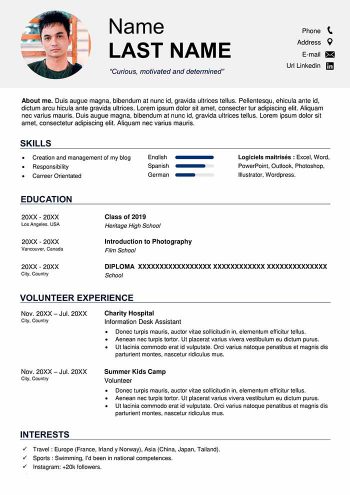
Cover Letter for Scholarship FAQs
What important guidelines to follow while crafting a cover letter for scholarship.
Here are some important guidelines to consider while crafting an effective cover letter for scholarship :
- Mention your quantifiable achievements, like your GPA.
- Enlist your future goals in a precise manner.
- Show your dedication to your field and its advancement.
- Maintain a polite and professional tone.
Can I use the same cover letter for multiple scholarship applications?
No, you cannot use the same cover letter for multiple scholarship applications. Every scholarship has different requirements and eligibility criteria . In order to showcase your genuine interest, it is advised to tailor your cover letter for every scholarship program.
How to download this free cover letter for scholarship?
To download this free cover letter for scholarship , follow the below steps:
- Scroll to the upper right corner of the page.
- Select the Word format compatible with your device.
- Click the download box.
- Start editing.
Free download our CV Templates
Free Resume Templates to Download in Word
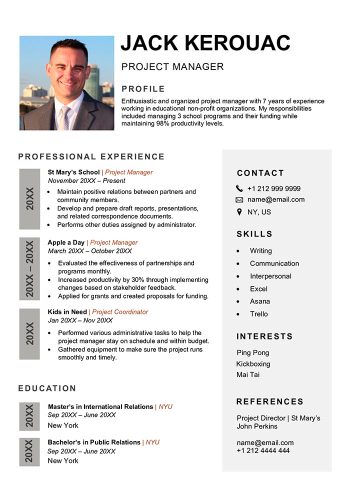

Academic Cover Letters
What is this handout about.
The long list of application materials required for many academic teaching jobs can be daunting. This handout will help you tackle one of the most important components: the cover letter or letter of interest. Here you will learn about writing and revising cover letters for academic teaching jobs in the United States of America.
What is an academic cover letter?
An academic cover letter describes your experiences and interest as a candidate for a specific position. It introduces you to the hiring committee and demonstrates how your academic background fits with the description of the position.
What do cover letters for academic teaching jobs typically contain?
At their most basic level, academic cover letters accomplish three things: one, they express your interest in the job; two, they provide a brief synopsis of your research and teaching; and three, they summarize your past experiences and achievements to illustrate your competence for the job. For early-career scholars, cover letters are typically no more than two pages (up to four pages for senior scholars). Occasionally, a third page may make sense for an early-career scholar if the application does not require a separate teaching statement and/or research statement. Digital versions of cover letters often contain hyperlinks to your CV or portfolio page. For some fields, cover letters may also include examples of your work, including music, popular articles, and other multimedia related to your research, service, or teaching available online. Typically, letters appear on departmental or university letterhead and include your signature. Above all, a strong cover letter presents your accomplishments and your familiarity with the institution and with the position.
How should I prepare to write my academic cover letter?
Like all writing, composing a cover letter is a process. The process may be as short as a few hours or as long as several weeks, but at the end the letter should present you as a strong candidate for the job. The following section has tips and questions for thinking through each stage of this writing process. You don’t need to answer all of these questions to write the letter; they are meant to help you brainstorm ideas.
Before you begin writing your cover letter, consider researching the institution, the department, and the student population. Incorporating all three aspects in your letter will help convey your interest in the position.
Get to know the institution. When crafting your cover letter, be aware of the type of institution to which you are applying. Knowing how the institution presents itself can help you tailor your letter and make it more specific.
- Where is the institution located?
- Is it on a quarter-system or semester-system?
- What type of institution is it? Is it an R1? Is it an R2? Is it a liberal arts college? Is it an HBCU? Is it a community college? A private high school?
- What is the institution’s culture? Is it teaching-focused or research-focused? Does it privilege experiential learning? Does it value faculty involvement outside the classroom? Is it affiliated with a specific religious tradition?
- Does it have any specific institutional commitments?
- How does the institution advocate for involvement in its local community?
- What are the professional development opportunities for new and junior faculty?
Learn about the department. Knowing the specific culture and needs of the department can help you reach your audience: the department members who will be reading your documents and vetting you as a candidate.
- Who is on the search committee? Who is the search committee chair?
- What is the official name of the department?
- Which different subfields make up the department?
- Is it a dual appointment or a position in a dual department?
- How does the department participate in specific types of student outreach?
- Does the department have graduate students? Does it offer a terminal Master’s degree, Ph.D., or both? How large are the cohorts? How are they funded?
- Does the department encourage or engage in interdisciplinary work?
- Does the majority of the department favor certain theoretical or methodological approaches?
- Does the department have partnerships with local institutions? If so, which ones?
- Is the department attempting to fill a specific vacancy, or is it an entirely new position?
- What are the typical course offerings in the department? Which courses might you be expected to teach? What courses might you be able to provide that are not currently available?
Consider the students. The search committee will often consider how you approach instructing and mentoring the student body. Sometimes committees will even reserve a position for a student or solicit student feedback on a candidate:
- What populations constitute the majority of the undergraduate population?
- Have there been any shifts in the student population recently?
- Do students largely come from in-state or out-of-state?
- Is there an international student population? If so, from which countries?
- Is the university recruiting students from traditionally underrepresented populations?
- Are students particularly active on campus? If so, how?
Many answers to these questions can be found both in the job description and on the institution’s website. If possible, consider contacting someone you know at the institution to ask about the culture directly. You can also use the institution’s course catalog, recruitment materials, alumni magazine, and other materials to get answers to these questions. The key is to understand the sort of institution to which you are applying, its immediate needs, and its future trajectory.
Remember, there is a resource that can help you with all three aspects—people. Reach out to your advisor, committee members, faculty mentors, and other contacts for insight into the prospective department’s culture and faculty. They might even help you revise your letter based on their expertise. Think of your job search as an opportunity to cultivate these relationships.
After you have done some initial research, think about how your experiences have prepared you for the job and identify the ones that seem the most relevant. Consider your previous research, internships, graduate teaching, and summer experiences. Here are some topics and questions to get you started thinking about what you might include.
Research Experiences. Consider how your research has prepared you for an academic career. Since the letter is a relatively short document, select examples of your research that really highlight who you are as a scholar, the direction you see your work going, and how your scholarship will contribute to the institution’s research community.
- What are your current research interests?
- What topics would you like to examine in the future?
- How have you pursued those research interests?
- Have you traveled for your research?
- Have you published any of your research? Have you presented it at a conference, symposium, or elsewhere?
- Have you worked or collaborated with scholars at different institutions on projects? If so, what did these collaborations produce?
- Have you made your research accessible to your local community?
- Have you received funding or merit-based fellowships for your research?
- What other research contributions have you made? This may include opinion articles, book chapters, or participating as a journal reviewer.
- How do your research interests relate to those of other faculty in the department or fill a gap?
Teaching Experience. Think about any teaching experience you may have. Perhaps you led recitations as a teaching assistant, taught your own course, or guest lectured. Pick a few experiences to discuss in your letter that demonstrate something about your teaching style or your interest in teaching.
- What courses are you interested in teaching for the department? What courses have you taught that discussed similar topics or themes?
- What new courses can you imagine offering the department that align with their aim and mission?
- Have you used specific strategies that were helpful in your instruction?
- What sort of resources do you typically use in the classroom?
- Do you have anecdotes that demonstrate your teaching style?
- What is your teaching philosophy?
- When have you successfully navigated a difficult concept or topic in the classroom, and what did you learn?
- What other opportunities could you provide to students?
Internships/Summer/Other Experiences. Brainstorm a list of any conferences, colloquiums, and workshops you have attended, as well as any ways you have served your department, university, or local community. This section will highlight how you participate in your university and scholarly community. Here are some examples of things you might discuss:
- Professional development opportunities you may have pursued over the summer or during your studies
- International travel for research or presentations
- Any research you’ve done in a non-academic setting
- Presentations at conferences
- Participation in symposia, reading groups, working groups, etc.
- Internships in which you may have implemented your research or practical skills related to your discipline
- Participation in community engagement projects
- Participation in or leadership of any scholarly and/or university organizations
In answering these questions, create a list of the experiences that you think best reflect you as a scholar and teacher. In choosing which experiences to highlight, consider your audience and what they would find valuable or relevant. Taking the time to really think about your reader will help you present yourself as an applicant well-qualified for the position.
Writing a draft
Remember that the job letter is an opportunity to introduce yourself and your accomplishments and to communicate why you would be a good fit for the position. Typically, search committees will want to know whether you are a capable job candidate, familiar with the institution, and a great future addition to the department’s faculty. As such, be aware of how the letter’s structure and content reflect your preparedness for the position.
The structure of your cover letter should reflect the typical standards for letter writing in the country in which the position is located (the list below reflects the standards for US letter writing). This usually includes a salutation, body, and closing, as well as proper contact information. If you are affiliated with a department, institution, or organization, the letter should be on letterhead.
- Use a simple, readable font in a standard size, such as 10-12pt. Some examples of fonts that may be conventional in your field include Arial, Garamond, Times New Roman, and Verdana, among other similar fonts.
- Do not indent paragraphs.
- Separate all paragraphs by a line and justify them to the left.
- Make sure that any included hyperlinks work.
- Include your signature in the closing.
Before you send in your letter, make sure you proofread and look for formatting mistakes. You’ll read more about proofreading and revising later in this handout!
The second most important aspect of your letter is its content. Since the letter is the first chance to provide an in-depth introduction, it should expand on who you are as a scholar and possible faculty member. Below are some elements to consider including when composing your letter.
Identify the position you are applying to and introduce yourself. Traditionally, the first sentence of a job letter includes the full name of the position and where you discovered the job posting. This is also the place to introduce yourself and describe why you are applying for this position. Since the goal of a job letter is to persuade the search committee to include you on the list of candidates for further review, you may want to include an initial claim as to why you are a strong candidate for the position. Some questions you might consider:
- What is your current status (ABD, assistant professor, post-doc, etc.)?
- If you are ABD, have you defended your dissertation? If not, when will you defend?
- Why are you interested in this position?
- Why are you a strong candidate for this position?
Describe your research experience and interests. For research-centered positions, such as positions at R1 or other types of research-centered universities, include information about your research experience and current work early in the letter. For many applicants, current work will be the dissertation project. If this is the case, some suggest calling your “dissertation research” your “current project” or “work,” as this may help you present yourself as an emerging scholar rather than a graduate student. Some questions about your research that you might consider:
- What research experiences have you had?
- What does your current project investigate?
- What are some of the important methods you applied?
- Have you collaborated with others in your research?
- Have you acquired specific skills that will be useful for the future?
- Have you received special funding? If so, what kind?
- Has your research received any accolades or rewards?
- What does your current project contribute to the field?
- Where have you presented your research?
- Have you published your research? If so, where? Or are you working on publishing your work?
- How does your current project fit the job description?
Present your plans for future research. This section presents your research agenda and usually includes a description of your plans for future projects and research publications. Detailing your future research demonstrates to the search committee that you’ve thought about a research trajectory and can work independently. If you are applying to a teaching-intensive position, you may want to minimize this section and/or consider including a sentence or two on how this research connects to undergraduate and/or graduate research opportunities. Some questions to get you started:
- What is your next research project/s?
- How does this connect to your current and past work?
- What major theories/methods will you use?
- How will this project contribute to the field?
- Where do you see your specialty area or subfield going in the next ten years and how does your research contribute to or reflect this?
- Will you be collaborating with anyone? If so, with whom?
- How will this future project encourage academic discourse?
- Do you already have funding? If so, from whom? If not, what plans do you have for obtaining funding?
- How does your future research expand upon the department’s strengths while simultaneously diversifying the university’s research portfolio? (For example, does your future research involve emerging research fields, state-of-the-art technologies, or novel applications?)
Describe your teaching experience and highlight teaching strategies. This section allows you to describe your teaching philosophy and how you apply this philosophy in your classroom. Start by briefly addressing your teaching goals and values. Here, you can provide specific examples of your teaching methods by describing activities and projects you assign students. Try to link your teaching and research together. For example, if you research the rise of feminism in the 19th century, consider how you bring either the methodology or the content of your research into the classroom. For a teaching-centered institution, such as a small liberal arts college or community college, you may want to emphasize your teaching more than your research. If you do not have any teaching experience, you could describe a training, mentoring, or coaching situation that was similar to teaching and how you would apply what you learned in a classroom.
- What is your teaching philosophy? How is your philosophy a good fit for the department in which you are applying to work?
- What sort of teaching strategies do you use in the classroom?
- What is your teaching style? Do you lecture? Do you emphasize discussion? Do you use specific forms of interactive learning?
- What courses have you taught?
- What departmental courses are you prepared to teach?
- Will you be able to fill in any gaps in the departmental course offerings?
- What important teaching and/or mentoring experiences have you had?
- How would you describe yourself in the classroom?
- What type of feedback have you gotten from students?
- Have you received any awards or recognition for your teaching?
Talk about your service work. Service is often an important component of an academic job description. This can include things like serving on committees or funding panels, providing reviews, and doing community outreach. The cover letter gives you an opportunity to explain how you have involved yourself in university life outside the classroom. For instance, you could include descriptions of volunteer work, participation in initiatives, or your role in professional organizations. This section should demonstrate ways in which you have served your department, university, and/or scholarly community. Here are some additional examples you could discuss:
- Participating in graduate student or junior faculty governance
- Sitting on committees, departmental or university-wide
- Partnerships with other university offices or departments
- Participating in community-partnerships
- Participating in public scholarship initiatives
- Founding or participating in any university initiatives or programs
- Creating extra-curricular resources or presentations
Present yourself as a future faculty member. This section demonstrates who you will be as a colleague. It gives you the opportunity to explain how you will collaborate with faculty members with similar interests; take part in departmental and/or institution wide initiatives or centers; and participate in departmental service. This shows your familiarity with the role of faculty outside the classroom and your ability to add to the departmental and/or institutional strengths or fill in any gaps.
- What excites you about this job?
- What faculty would you like to collaborate with and why? (This answer may be slightly tricky. See the section on name dropping below.)
- Are there any partnerships in the university or outside of it that you wish to participate in?
- Are there any centers associated with the university or in the community that you want to be involved in?
- Are there faculty initiatives that you are passionate about?
- Do you have experience collaborating across various departments or within your own department?
- In what areas will you be able to contribute?
- Why would you make an excellent addition to the faculty at this institution?
Compose a strong closing. This short section should acknowledge that you have sent in all other application documents and include a brief thank you for the reader’s time and/or consideration. It should also state your willingness to forward additional materials and indicate what you would like to see as next steps (e.g., a statement that you look forward to speaking with the search committee). End with a professional closing such as “Sincerely” or “Kind Regards” followed by your full name.
If you are finding it difficult to write the different sections of your cover letter, consider composing the other academic job application documents (the research statement, teaching philosophy, and diversity statement) first and then summarizing them in your job letter.
Different kinds of letters may be required for different types of jobs. For example, some jobs may focus on research. In this case, emphasize your research experiences and current project/s. Other jobs may be more focused on teaching. In this case, highlight your teaching background and skills. Below are two models for how you could change your letter’s organization based on the job description and the institution. The models offer a guide for you to consider how changing the order of information and the amount of space dedicated to a particular topic changes the emphasis of the letter.
Research-Based Position Job Letter Example:
Teaching-based position job letter example:.
Remember your first draft does not have to be your last. Try to get feedback from different readers, especially if it is one of your first applications. It is not uncommon to go through several stages of revisions. Check out the Writing Center’s handout on editing and proofreading and video on proofreading to help with this last stage of writing.
Potential pitfalls
Using the word dissertation. Some search committee members may see the word “dissertation” as a red flag that an applicant is too focused on their role as a graduate student rather than as a prospective faculty member. It may be advantageous, then, to describe your dissertation as current research, a current research project, current work, or some other phrase that demonstrates you are aware that your dissertation is the beginning of a larger scholarly career.
Too much jargon. While you may be writing to a specific department, people on the search committee might be unfamiliar with the details of your subfield. In fact, many committees have at least one member from outside their department. Use terminology that can easily be understood by non-experts. If you want to use a specific term that is crucial to your research, then you should define it. Aim for clarity for your reader, which may mean simplification in lieu of complete precision.
Overselling yourself. While your job letter should sell you as a great candidate, saying so (e.g., “I’m the ideal candidate”) in your letter may come off to some search committee members as presumptuous. Remember that although you have an idea about the type of colleague a department is searching for, ultimately you do not know exactly what they want. Try to avoid phrases or sentences where you state you are the ideal or the only candidate right for the position.
Paying too much attention to the job description. Job descriptions are the result of a lot of debate and compromise. If you have skills or research interests outside the job description, consider including them in your letter. It may be that your extra research interests; your outside skills; and/or your extracurricular involvements make you an attractive candidate. For example, if you are a Latin Americanist who also happens to be well-versed in the Spanish Revolution, it could be worth mentioning the expanse of your research interests because a department might find you could fill in other gaps in the curriculum or add an additional or complementary perspective to the department.
Improper sendoff. The closing of your letter is just as important as the beginning. The end of the letter should reflect the professionalism of the document. There should be a thank-you and the word sincerely or a formal equivalent. Remember, it is the very last place in your letter where you present yourself as a capable future colleague.
Small oversights. Make sure to proofread your letter not just for grammar but also for content. For example, if you use material from another letter, make sure you do not include the names of another school, department, or unassociated faculty! Or, if the school is in Chicago, make sure you do not accidentally reference it as located in the Twin Cities.
Name dropping. You rarely know the internal politics of the department or institution to which you are applying. So be cautious about the names you insert in your cover letters. You do not want to unintentionally insert yourself into a departmental squabble or add fire to an interdepartmental conflict. Instead, focus on the actions you will undertake and the initiatives you are passionate about.
Works consulted
We consulted these works while writing this handout. This is not a comprehensive list of resources on the handout’s topic, and we encourage you to do your own research to find additional publications. Please do not use this list as a model for the format of your own reference list, as it may not match the citation style you are using. For guidance on formatting citations, please see the UNC Libraries citation tutorial . We revise these tips periodically and welcome feedback.
Ball, Cheryl E. 2013. “Understanding Cover Letters.” Inside Higher Ed , November 3, 2013. https://www.insidehighered.com/advice/2013/11/04/essay-cover-letter-academic-jobs .
Borchardt, John. 2014. “Writing a Winning Cover Letter.” Science Magazine , August 6, 2014. https://www.sciencemag.org/careers/2014/08/writing-winning-cover-letter# .
Helmreich, William. 2013. “Your First Academic Job.” Inside Higher Ed , June 17, 2013. https://www.insidehighered.com/advice/2013/06/17/essay-how-land-first-academic-job .
Kelsky, Karen. 2013. “How To Write a Journal Article Submission Cover Letter.” The Professor Is In (blog), April 26, 2013. https://theprofessorisin.com/2013/04/26/how-to-write-a-journal-article-submission-cover-letter/ .
Tomaska, Lubomir, and Josef Nosek. 2008. “Ten Simple Rules for Writing a Cover Letter to Accompany a Job Application for an Academic Position.” PLoS Computational Biology 14(5). https://doi.org/10.1371/journal.pcbi.1006132 .
You may reproduce it for non-commercial use if you use the entire handout and attribute the source: The Writing Center, University of North Carolina at Chapel Hill
Make a Gift
- Sample Letters
FREE 4+ Cover Letter for Scholarship in MS Word | PDF
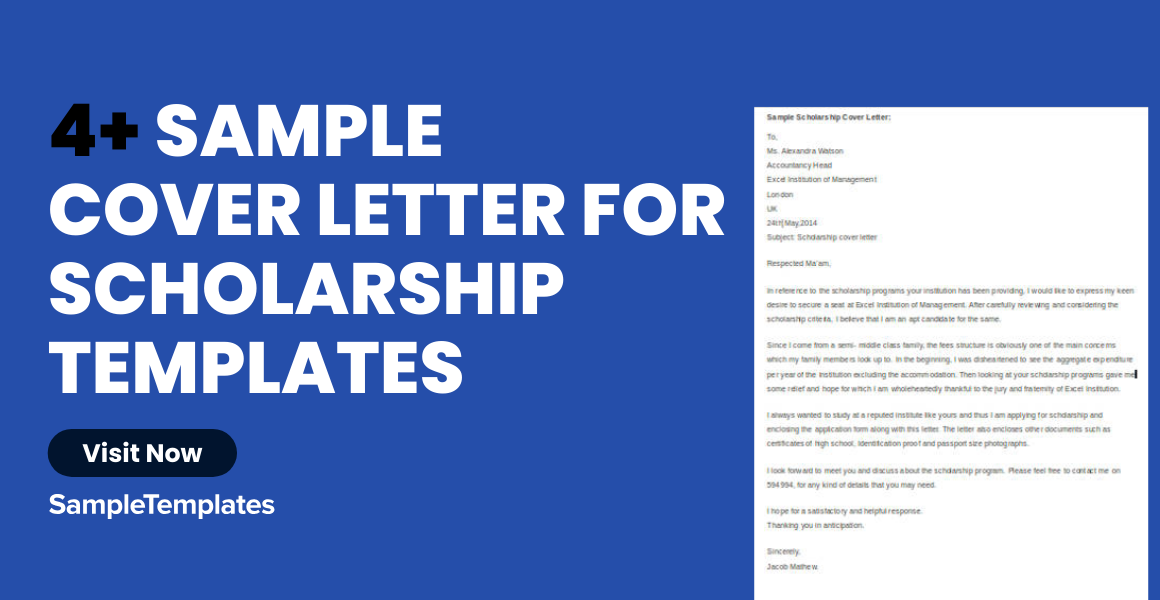
With school tuition fees amounting to such a large amount nowadays, getting a scholarship grant will be a great help to aid you financially as you study in a prestigious university analysis or college analysis. Scholarships are not granted to just anyone. Careful consideration must be done and factors such as the economic status and academic excellence of the applicant must be looked into.
Cover Letter For Scholarship
Sample scholarship application letter - 6+ documents in pdf, word, sample letter of recommendation for scholarship - 15+ examples ..., application letter - 9+ free doc download.
To ensure that you will get a scholarship, you should write an exemplary application letter that would aid you to achieve your education goals and future goals for your future career. You can look into the set of Sample Cover Letters for the scholarship we have that is available for download in Word and PDF format.
Sample Cover Letter for Scholarship Application in DOC
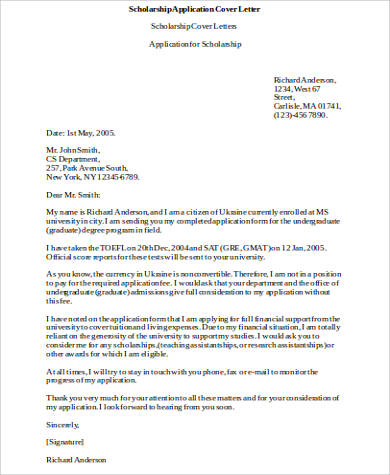
Cover Letter Examples for Scholarship Template
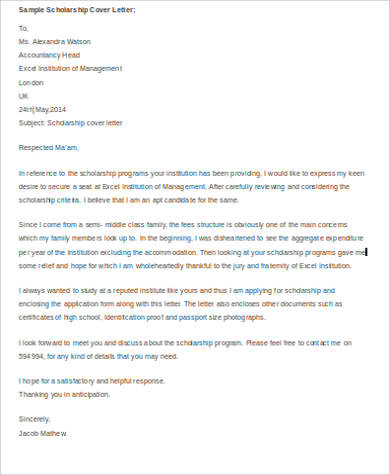
Sample Scholarship Cover Letter Template
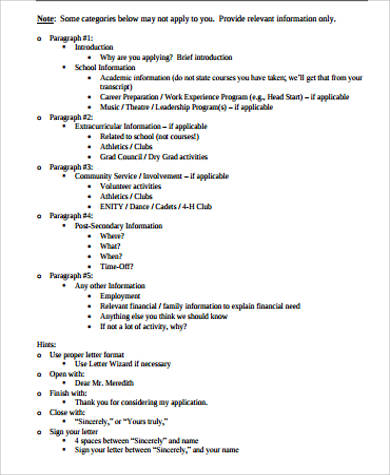
Size: 177 KB
Scholarship Program Cover Letter Outline Template
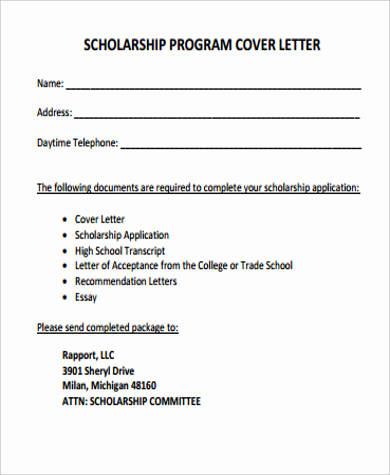
Size: 1004 KB
Tips in Writing an Effective Cover Letter for Scholarship
In writing your scholarship application letters, you must be able to give a justifiable reason why you should be chosen to be granted a scholarship to aid you financially with your studies. Here are a few tips you can follow when writing your letters .
- Use language that is easy to understand and formal in tone.
- Explain in detail why you have considered applying for a scholarship.
- Write all your credentials that showcase you as being an achiever. Make sure you cover all the essential details needed to let them know why you are a good match to be granted a scholarship.
- You may also include the organizations you were part of to showcase that you are a team player.
- Your letter should show that you are confident and that you are looking forward to getting the scholarship grant.
- Always check and review your letter for any grammatical errors or misspelled words. You may also opt to have someone else proofread your letter.
Your scholarship application letters will pave the way to quality education that could bring your future career to new heights. You can look into Cover Letters for Job Application if you are looking into applying for a job.
Simple Scholarship Cover Letter Doc
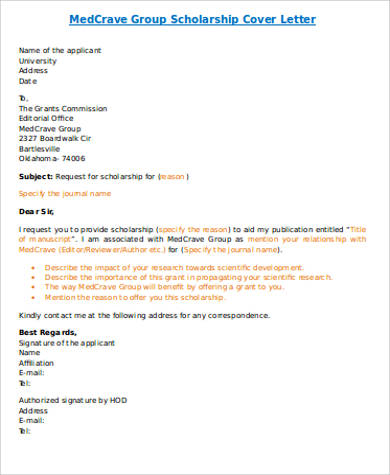
Size: 46 KB
Using Cover Letter for Scholarship Templates
These cover letter templates are very accessible. You can easily be downloaded directly from this page. All you need to do is choose one that you feel will be most effective and click on the Download button at the bottom of your chosen document. They are available in Word and PDF format, can be saved to your computer or portable device, and will not take up too much of its memory. These will be the best guidelines you can use in order to make your scholarship application successful.
Getting a scholarship grant is a big help especially for those who are having difficulties with their finances. You have to ensure that when you are writing your sample application you are able to put your best foot forward in order to convince the sponsors that you are a good fit for financial assistance. A cover letter for scholarship’s main purpose is to highlight your strengths and goals. It is meant to be centered on what you have achieved academically. You have to carefully evaluate what you are going to include in order for you to be chosen for the scholarship.
Planning to have a career in teaching? You can definitely benefit from using our sample Cover Letters for Teacher .
Related Posts
Sample motivation letter templates, sample college letter of intent, sample invitation letters for visa, sample teaching position recommendation letter templates, sample visa invitation letter templates, how to write an application letter for employment [ with samples ], sample community service letter templates, sample commitment letter templates, sample application letter templates, letterhead samples, sample visa sponsorship letter templates, application letter templates, sample job application cover letter templates, formal excuse letter templates, leave letter templates, sample basic cover letter - 8+ examples in word, pdf, sample resume cover letter format - 9+ examples in word, pdf, sample marketing assistant cover letter - 8+ free documents in ..., sample career change cover letter - 6+ examples in word, pdf.

IMAGES
VIDEO
COMMENTS
Recipient's name] / [Scholarship Committee], Start with an opening paragraph that briefly introduces who you are, and your relevant experience, how you learned about the scholarship, and why you are interested in applying. If writing multiple cover letters, take care to customize this paragraph to target a specific scholarship.
Example cover letter for a scholarship. Consider this example of a cover letter for a scholarship to help guide you as you write: Dear Ms. Adams, My name is Eloise Barone, and I'm writing to submit my application for the Ridge Hills University financial aid program for the spring 2024 semester. I'm currently a first-year student enrolled in the ...
A fill-in-the-blanks template that will produce your cover letter for scholarship within 15 minutes. Save hours of work and get a cover letter like this. Pick a template, fill it in. Quick and easy. Choose from 18+ cover letter templates and download your cover letter now. Create your cover letter now.
Here's a list of steps you can follow to write a scholarship application letter: 1. Review the organization's requirements. Before you create a draft of your scholarship application letter, consider reviewing the designating body's expectations to familiarize yourself with what they're looking for in a scholarship candidate.
Scholarship Cover Letter Example. To Whom It May Concern, My name is Alex Smith and I am a high school senior in Bend, Ohio. In the fall of 2019, I will be starting my freshman year at the University of Pennsylvania at the Annenberg School of Communication with an intended major in communications.
6. Write a concluding paragraph. After completing the body of the letter, write a concluding paragraph summarizing your credentials and goals. Use this paragraph to express your gratitude to the scholarship sponsor and board for providing the opportunity. You may also include your contact information in case they have questions regarding your ...
This cover letter starts by explaining why the applicant is applying. She states what the application is for - researchers with chronic illnesses - and then goes on to explain her own chronic illness, as well as why research in this field could be beneficial. This immediately positions her as the best candidate for the scholarship, as not ...
Dear [Contact Name], Introduction paragraph: State your name, current grade/year in school, intended major, and why you want the scholarship. Share your academic and career goals. Paragraph 2: Highlight your relevant academic achievements like GPA, honors, awards, and advanced coursework.
The best way to do it is by including "Dear", then addressing the name of the committee with a Mr. or Ms. 3. Opening letter. Now is the time to get into your paragraphs of the scholarship cover letter. In this paragraph, you should make a brief introduction of yourself including your experience.
No matter what type of scholarship you apply for, all cover letter examples for students follow a standard format. So, follow the following steps to write the best cover letter for a scholarship you can. Tip #1 - Adhere to the Structure. It can be a real challenge to sell yourself to the scholarship committee.
3. Career Goals and Aspirations: Discuss your long-term goals and how the scholarship will contribute. Showcase your passion and commitment to your chosen field of study. 4. Relevant Experience. Share any relevant work, research, or volunteer experiences. Connect these experiences to the scholarship's objectives. 5.
Download cover letter for a scholarship sample Cover Letter Template Scholarship PDF. This section will guide through some scholarship cover letter examples which will also act as a cover letter for scholarship application template for you to start with. There are several circumstances that require different types of cover letter for scholarships.
We have come up with perfect scholarship application cover letter templates on our website that are easy to follow and understand. Feel free to download them and practice. Scholarship Cover Letter Sample 01. Download. Scholarship Cover Letter Sample 02. Download. Scholarship Cover Letter Sample 03. Download.
Learn how to write a scholarship application letter by taking the following steps: 1. Examine the eligibility requirements for the scholarship. The scholarships you apply for vary in terms of expectations, requirements and preferences. Carefully examine the specific requirements of each scholarship you're considering.
You will need to use your best judgment to write a concise motivation letter. The letter should include: The most important elements of your resume. Your education. Your professional experiences and plans for the future. Motivation letters are usually around 500-1,000 words. Split them into paragraphs for easy reading.
Cover Letter for a Scholarship Example. Full Name Address Phone Number Email Address. Scholarship Organization's Name Scholarship Organization's Address. Dear (Mr/Mrs or Academic Title) (Surname), I am writing to express my strong interest in the ABC Scholarship for the pursuit of a Master's degree in Architecture at XYZ University. With ...
Scholarship letter of application sample Here's an example of a scholarship letter of application that may help you when you're writing your own: Caroline Price 0132 465 375 [email protected] 15th June, 2022 Mr. M. Lucas Director of Scholarship Affairs Brisbane Family Technologies Dear Mr. Lucas, My name is Caroline Price and I have recently received an acceptance letter to the Upper Lake ...
Here is a list of steps you can follow to write a scholarship cover letter: 1. Review the scholarship qualifications. There are a variety of scholarships to apply for, and their organisations may have different expectations, requirements and preferences. It is essential to review the scholarship qualifications before you write your cover letter ...
A cover letter should be addressed to a named person i.e. "Dear Professor Smith". For a PhD application, this will usually be the PhD supervisor, but may be a specific person in charge of recruitment. If you are still unsure who to address the cover letter to, it should be directed to the Head of Department.
At their most basic level, academic cover letters accomplish three things: one, they express your interest in the job; two, they provide a brief synopsis of your research and teaching; and three, they summarize your past experiences and achievements to illustrate your competence for the job. For early-career scholars, cover letters are ...
Some scholarships ask for specific information to be addressed in the cover letter. This is where you would put that information. Closing Paragraph: Refer the reader to your enclosed application, résumé, transcript, etc. and thank them for taking the time to review your application. Left & Right 1.5".
Example of a Ph.D. cover letter Use this academic cover example template as inspiration for writing your own: Gary Zhang 100 Baker Avenue Clairesville, WY (838)-556-9092 [email protected] Dear Dr. Morales, I am writing to express my interest in the doctoral program for the Department of Biochemical Engineering at Agosto University. Using my current and future research, I plan to develop ...
A cover letter for scholarship's main purpose is to highlight your strengths and goals. It is meant to be centered on what you have achieved academically. You have to carefully evaluate what you are going to include in order for you to be chosen for the scholarship.